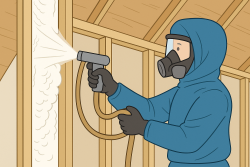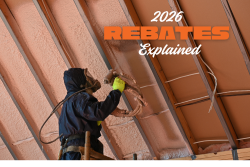Very few people don’t appreciate the beauty and character of an old home, especially one that has been well taken care of or possibly renovated/updated while maintaining many of the original features. Often when people see such a home, they are tempted to purchase one for themselves, possibly even a “fixer-upper”. However, it’s easy to look at a finished product and be unaware of or ignore the sometimes negative reality of such a home. Aside from the cosmetic undertaking, there may be many structural and mechanical deficiencies which you will want to address. One such item which should be considered at the top of the list is insulation.
YOUR HOME’S INSULATION STATUS
Many older homes have little to no insulation, and those which do most likely need it to be inspected at the very least. Getting a clear picture of the status of the insulation in your home requires a thorough inspection. A reputable insulation company will use a thermal camera to detect heat loss areas throughout the home, both from lack of sufficient insulation and through air leakage.
AIRFLOW IN THE ATTIC
A visual inspection is also important, particularly in the attic. Oftentimes it is found that the insulation in the attic of older homes is quite minimal. What is there may have been moved around a surprisingly large amount by animals? Also, the insulation may not extend the right to the top plate of the walls. To the other extreme, the insulation may extend right into the eaves, blocking the soffit vents. Many people are unaware that airflow is actually desirable in attics, year-round, and if the soffit vents are blocked, a host of problems can occur, including moisture build-up and its ensuing concern for mould. Another sign of poor attic insulation is large icicles winter hanging from the eaves. They’re very pretty, especially at Christmas, but they are also an indication of heat loss in the attic.
OTHER SIGNS OF POOR INSULATION
Aside from the attic, walls quite often have no insulation whatsoever, allowing heat or cold to transfer quite easily from inside to out and vice versa. Blown-in or spray foam insulation is well suited to this situation. Finally, the ring joist, which is a board on the edge running atop the perimeter of the foundation and upon which the first-floor sheeting sits, is a common source of air leakage and heat/cold transfer. Sealing and insulating this important structural component is well advised.
CHOOSING YOUR INSULATION COMPANY
After careful consideration of all of the aforementioned, if you decide to go ahead with the project, there are several attributes you will want your chosen insulation company to possess:
- Are they a well-known, well-established, reputable firm? This is probably the most important question. All too often insulation jobs are rewarded on price alone. But are customers really getting the best price if inferior materials or inferior installation are the results? What about follow-up if a problem occurs? Will they stand behind their work? Don’t skip the very valuable step of asking for references.
- Will they work with you to create an action plan, describing the process in detail, and do they take the time to answer all of your questions and concerns?
- Do they provide you with different material/installation options, their pros and cons, and their respective prices?
- Are all of their materials CCMC (Canadian Construction Materials Centre) approved?
- Will they complete the job timely and with a particular bent on cleanliness when all is said and done?
If your insulation company can answer all of these questions in the affirmative, such as Reitzel Insulation, you have definitely found yourself a professional company, and you can rest at ease and experience complete satisfaction with your insulation project.


















